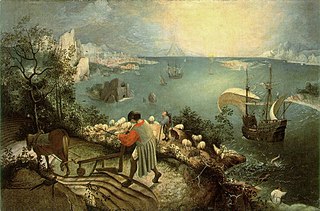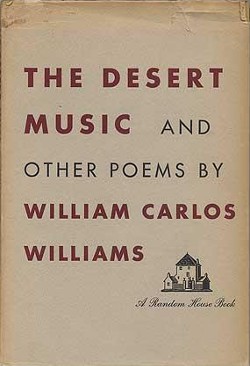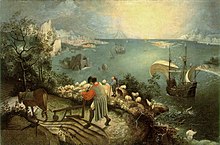
In Greek mythology, Daedalus was a skillful architect and craftsman, seen as a symbol of wisdom, knowledge and power. He is the father of Icarus, the uncle of Perdix, and possibly also the father of Iapyx. Among his most famous creations are the wooden cow for Pasiphaë, the Labyrinth for King Minos of Crete which imprisoned the Minotaur, and wings that he and his son Icarus used to attempt to escape Crete. It was during this escape that Icarus did not heed his father's warnings and flew too close to the sun; the wax holding his wings together melted and Icarus fell to his death.

William Carlos Williams was an American poet, writer, and physician closely associated with modernism and imagism.

Pieter Bruegelthe Elder was the most significant artist of Dutch and Flemish Renaissance painting, a painter and printmaker, known for his landscapes and peasant scenes ; he was a pioneer in making both types of subject the focus in large paintings.

In Greek mythology, Icarus was the son of the master craftsman Daedalus, the architect of the labyrinth of Crete. After Theseus, king of Athens and enemy of Minos, escaped from the labyrinth, King Minos suspected that Icarus and Daedalus had revealed the labyrinth's secrets and imprisoned them—either in a large tower overlooking the ocean or the labyrinth itself, depending upon the account. Icarus and Daedalus escaped using wings Daedalus constructed from feathers, threads from blankets, clothes, and beeswax. Daedalus warned Icarus first of complacency and then of hubris, instructing him to fly neither too low nor too high, lest the sea's dampness clog his wings or the sun's heat melt them. Icarus ignored Daedalus’s instructions not to fly too close to the sun, causing the beeswax in his wings to melt. Icarus fell from the sky, plunged into the sea, and drowned. The myth gave rise to the idiom, "fly too close to the sun."

Pictures from Brueghel and Other Poems is a 1962 book of poems by the American modernist poet/writer William Carlos Williams. It was Williams's final book, for which he posthumously won the Pulitzer Prize for Poetry in 1963. Two previously-published collections of poetry are included: The Desert Music and Other Poems from 1954 and Journey to Love from 1955.

"Musée des Beaux Arts" is a twenty-three line poem written by W. H. Auden in December 1938 while he was staying in Brussels, Belgium, with Christopher Isherwood. It was first published under the title "Palais des beaux arts" in the Spring 1939 issue of New Writing, a modernist magazine edited by John Lehmann. It next appeared in the collected volume of verse Another Time, which was followed four months later by the English edition. The poem's title derives from the Musées Royaux des Beaux-Arts de Belgique, the French-language name for the Royal Museums of Fine Arts of Belgium located in Brussels. The museum is famous for its collection of Early Netherlandish painting. When Auden visited the museum he would have seen a number of the paintings of the "Old Masters" referred to in the second line of the poem, including the Fall of Icarus which at the time was still regarded as an original by Pieter Bruegel the Elder.

Landscape with the Fall of Icarus is a painting in oil on canvas measuring 73.5 by 112 centimetres now in the Royal Museums of Fine Arts of Belgium in Brussels. It was long thought to be by the leading painter of Dutch and Flemish Renaissance painting, Pieter Bruegel the Elder. However, following technical examinations in 1996 of the painting hanging in the Brussels museum, that attribution is regarded as very doubtful, and the painting, perhaps painted in the 1560s, is now usually seen as a good early copy by an unknown artist of Bruegel's lost original, perhaps from about 1558. According to the museum: "It is doubtful the execution is by Bruegel the Elder, but the composition can be said with certainty to be his", although recent technical research has re-opened the question.

"Flight of Icarus" is a song by the English heavy metal band Iron Maiden. It was their eighth single, the first from their fourth studio album, Piece of Mind (1983), and their first in the United States, where it was one of their few with substantial airplay, peaking at a personal best No. 8 on the Billboard Top Album Tracks chart. It was a lesser success in the UK, peaking at No. 11 on the UK Singles Chart.

Dutch and Flemish Renaissance painting represents the 16th-century response to Italian Renaissance art in the Low Countries, as well as many continuities with the preceding Early Netherlandish painting. The period spans from the Antwerp Mannerists and Hieronymus Bosch at the start of the 16th century to the late Northern Mannerists such as Hendrik Goltzius and Joachim Wtewael at the end. Artists drew on both the recent innovations of Italian painting and the local traditions of the Early Netherlandish artists.

The Desert Music and Other Poems was a 1954 Random House book collecting 1949-54 poems by the American modernist poet/writer William Carlos Williams. It is now collected, along with Pictures from Brueghel and Other Poems (1962) and Journey to Love (1955), in the New Directions paperback Pictures from Brueghel and other poems by William Carlos Williams: Collected Poems 1950-1962.

Journey to Love was a 1955 Random House book by the American modernist poet/writer William Carlos Williams. He dedicated it to his wife. All of the poems are in triadic stanza form, sometimes "with a short fourth line to fill out the measure."
Icarus is a character in Greek Mythology who fell to his death when the sun melted the wax holding together the wings he was using to fly.

The Order of Icarus (C.O.I.) is the highest aviation award next to the Trans-Canada (McKee) Trophy that is awarded to Canadian aviators who have made a lasting contribution to crewed flight. The order ceased existence in 1981.

The Blind Leading the Blind, Blind, or The Parable of the Blind is a painting by the Netherlandish Renaissance artist Pieter Bruegel the Elder, completed in 1568. Executed in distemper on linen canvas, it measures 86 cm × 154 cm. It depicts the Biblical parable of the blind leading the blind from the Gospel of Matthew 15:14, and is in the collection of the Museo di Capodimonte in Naples, Italy.
The Icarus complex is a term in psychoanalysis and personality theory first used by Henry A. Murray to describe a particular type of overambitious character. Psychosynthesis has applied it to those in whom spiritual ambition exceeds their personality limits, leading to a backlash.
Landscape with the Fall of Icarus may refer to:

A Man Was Going Down the Road is a novel written by Otar Chiladze in 1973. It was translated into English by Donald Rayfield in 2012.

The Wedge is a 1944 book of poems by American modernist writer and poet William Carlos Williams. He assembled this collection in response to requests from American servicemen during World War II for a pocket-sized collection of his work to take into deployment with them. Despite the poet's inquiries and the nature of the requests that prompted him to approach them, several publishers rejected The Wedge. Their grounds for doing so were a perceived lack of literary quality and wartime shortages. The book was eventually handset printed by Henry Duncan and Wightman Williams at Cummington Press and bound surreptitiously on the premises and at the expense of one of the publishers who had previously rejected it. The book is dedicated to poet Louis Zukofsky, who helped Williams revise and rearrange the poems for publication.

Landscape with the Fall of Icarus is an oil-on-canvas painting by Flemish painter Joos de Momper. It was possibly painted in the 1620s, and is currently housed at the Nationalmuseum in Stockholm.















